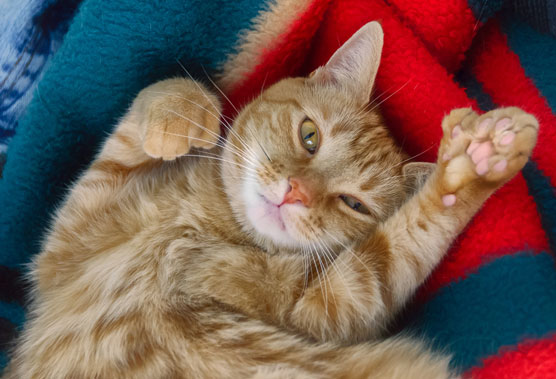So, what is a cat lover suffering from feline withdrawal to do? Even if you can’t book a room at a property with a resident feline, you don’t have to suffer without fur and purr while you’re on the road. To help you out, we’ve provided a brief guide to feline-friendly destinations. Some are so good they’re worth a trip all by themselves. Others are worth a look if you’re in the area already.
These destinations barely scratch the surface, and as cats continue to grow in popularity, there will surely be more places for cat lovers to enjoy the company of other cat fans — and felines too.
A lot of these places are run through the dedication of a single person or volunteers, and hours and days of operation may vary, and these sorts of operations can close without much notice. Moral: Always check ahead.
Yes, you can also pet friendly cats wherever you go. Many places are home to friendly cats who roam freely, and many have learned to hit up strangers for a bit of food or a scratch under the chin. While you’re more than likely fine petting a friendly cat, do be aware there is some risk, especially in areas where rabies is common. While the treatment for exposure to rabies is much less miserable than it used to be, it’s still no picnic. If you’re bitten by an animal with unknown vaccination status, or who cannot be caught to be tested, you’ll need to be treated. So, consider yourself warned, and be careful.
Hemingway House
When we put out a call for feline attractions, the Hemingway House in Key West, Florida, was the most-mentioned of must-visit places for cat lovers. And it’s no surprise: The attraction is real for both writers and cat lovers. (And everyone knows there’s a lot of overlap in those groups!) ©Lux Blue/Shutterstock.com
©Lux Blue/Shutterstock.comErnest Hemingway loved his cats, and so does everyone else, in part because they’re something special about them: They are polydactyl, meaning they have extra toes! Myth has it that the cats are the descendants of animals who hopped off ships after serving as ratters on board, and that’s as good an explanation as any. What’s with the extra toes, though? Such cats are not unheard of around the world, and since the trait is dominant in genetic terms, it takes only one copy of the gene from either parent to produce cats with extra toes.
Because of the interest in these cats, they’ve been favored by tourists for decades and allowed to breed more of their kind. They’re so famous now that any cat with extra toes is often called a Hemingway Cat nowadays, and you must admit that term easier to remember than “polydactyl”!
While there are certainly people who go to Key West just for the Hemingway cats, the island is such a tourist attraction that you’ll find plenty to do in addition to seeing some of the world’s most famous cats. One of them is even cat related: Ask around to see if Dominique LeFort, the “Catman of Key West,” is performing with his fabulous flying felines.
The American Museum of the House Cat
Near Asheville, North Carolina, you’ll find one of the quirky roadside attractions that used to be everywhere in the United States. While many such places never survived the transition from highways to super-highways, so many cat-lovers visit the American Museum of the House Cat that its survival seems assured. It’s not an old place, either. Opened in 2017, the owner, Dr. Harold Sims, has collected more than 5,000 cat-related items, including many antiques. Open from April to December, the museum represents more than 30 years of collecting by Sims, and proceeds go to a nearby cat shelter, which is also available to tour. The oldest exhibit is a bronze of a feline goddess said to date to 600 B.C. Located near the arts-and-crafts village of Dilsboro, you’ll find lots of other things to do as well in this North Carolina mountain community.Citywide cat celebration
The city of Catskill, New York, makes the most of its name with a seasonable celebration called Cat’n Around Catskill. While other touristy towns have raised money for worthy causes by having local businesses pay artists to paint sculptures of horses (as in the nearby horse-racing town of Saratoga), bears, elks or other large animals, Catskill decided to go feline, with larger than life painted sculptures on the town’s historic main drag. At the end of the season, the statues are auctioned off for charity. Pictures of these fantastic creations are available on the website, and the displays run throughout the town’s tourist season, which is May through September.Purrfectly pedigreed
Arguably the largest cat show in the world takes place every fall outside of Birmingham in the United Kingdom at the massive National Exhibition Centre, which also hosts the world’s largest dog show, Crufts, every spring. The aptly named Supreme Cat Show, held under the auspices of the Governing Council of the Cat Fancy, features judging of nearly every known breed of cat, along with educational seminars and so many and varied vendor booths (called “stalls” in the U.K.) filled with all manner of goodies for cats and those who love them.While you may not consider a cat show worthy of an overseas trip on its own, the area is incredible rich with historic attractions, from the town of Royal Leamington Spa (where rich and poor alike once enjoyed the baths), to Coventry, where the ruins of the cathedral bombed by in World War II stand in memory next to a new one erected in the promise of a post-war world.
When in Rome, help the cats
As long you have your passport out, why not head to Rome? The Torre Argentina Cat Sanctuary is in one of the most historic cat places in the world, found among the ancient ruins of this historic city. Free-ranging cat have always been a sight on the streets of Rome, going all the way back to the beginning of Western Civilization.The cats of Torre Argentina — about 150 more or less — are cared for by volunteers, including those who travel to take in the majestic ruins as well as the feline companionship. The sanctuary is named for the area, which is itself named for a Roman dictator who was assassinated in 44 BC.
Despite the ghosts who surely roam the area, the place has been home to friendly felines since 1929, when a string of gattare (cat ladies) started caring for the animals. A group of cat lovers realized the work was too much for a small group of volunteers, so in 1993, the sanctuary was formally founded. Financial backing and governmental tolerance has been up and down since, but the cats remain, and likely always will.
The ultimate destination for cat cafes
We’re sure that drinking coffee with cats is an experience shared the world over, the modern concept of the cat café — a coffee house with resident cats — seems to have started in Japan and spread worldwide from there. In Tokyo alone, there are so many cat cafes that there are websites dedicated to helping tourists and residents alike visit them all. Why Tokyo? Japan is famously feline-friendly but also densely populated enough in its biggest city that many people don’t have housing that accommodates a cat of their own.At a feline café, you go in, pay for your time (and food/beverage) and pet the friendly cats. The Calico Cat Café in the Shinjuku part of Tokyo is especially noteworthy, with more 50 cats in residence, but there are plenty of others! The website here is in Japanese, but an Internet search will pop lots of guidelines in other languages to guide your visit.
Hello Kitty!
Outside of Tokyo in the town of Tama is Sanrio Puroland, the official Hello Kitty theme park. Opened in 1990 and entirely indoors, the attraction is extremely popular, welcoming more than a million visitors per year. As befitting a world-famous brand, the attraction offers amazing shopping of Hello Kitty items, as well as those other themed items from the company that owns “Hello Kitty.”Once inside, you’ll be able to take in a show and snap selfies with costumed mascots. While the site is extremely popular with children and teenaged girls, there is also a loyal clientele of adult Hello Kitty fans that wouldn’t dream of missing out when visiting Japan. The website is in Japanese, so search for "Hello Kitty theme park, Tokyo," to get information in other languages.
Snuggle with a library cat (while you still can)
Near the beginning of her cat-writing career, Gina was enchanted with the work of Gary Roma, who produced a documentary, Puss in Books: Adventures of the Library Cat. She couldn’t wait to interview him, and wrote one of her favorite articles ever. A few years later, Viki Myron’s Dewey: The Small-Town Library Cat Who Touched the World became an international bestseller. Again, Gina couldn’t wait to interview the author, because libraries and cats, what’s not to like? ©Jeanette Virginia Goh/Shutterstock.com
©Jeanette Virginia Goh/Shutterstock.comUnfortunately, Gina’s view is not universal. Roma counted more than 200 libraries with resident cats in the 1980s, but the American Library Association was able to find less than 40 in a 2016 survey.
So, what happened? Allergies, mostly. People who are allergic to cats (or parents of children who are) complained to authorities about many of the cats. While some cats won the right to stay—often after considerable hissing on both sides—many others were rehomed or not replaced when they died.
Still, library cats hang on. Some are restricted to portions of the library or to staff areas only. Besides being wonderful for being cats, library cats have the most wonderful names. In addition to Dewey, there have been cats named Pages and Stacks, as well as more ordinary cats names such as Emma and Jasper (although to be fair, both of those names are literary references). Stacks, who lives in the New Castle, Pennsylvania, Public Library is purported to be one of the last library cats with full roaming privileges. He also has a social media following.
Kattenstoet—no, they don’t throw real cats anymore
The town of Ypres, Belgium, has an unfortunate history when it comes to free-roaming cats. In the middle ages, they were thrown to their deaths from a tower. (As awful as that is, cats were often treated horribly at that time all over Europe, in part because they were thought to be in league with Satan.)The days of cat throwing are long gone, thankfully, ending in the early 19th century, although art from the time still marks the history. These days, the town celebrates all things cat with Kattenstoet (“Cat Parade”), a festival held every three years (the 2018 edition was the 45th). The event features costumes, lectures, and lots of cool cat stuff. It ends with a ceremony throwing plush cats out of the same tower. While that sounds very weird still, it’s far better than the original practice, as almost everyone agrees.
Safe home for big cats
The Performing Animal Welfare Society (PAWS) was founded by the late Pat Derby, a Hollywood animal trainer who was appalled by the treatment of non-domesticated performing animals, especially elephants. In 1984, she founded a 30-acre sanctuary in Galt, California, near the state capital of Sacramento. With the financial backing of the late Amanda Blake, who played Miss Kitty on the old TV show, Gunsmoke, Derby set out to take in elephants, lions, tigers and other animals who needed a safe, permanent home.As support grew, so did the operation, which was expanded in 1997 when the Sacramento Municipal Utility District provided more land on the grounds of a shuttered nuclear power plant. Further growth came with the acquisition of 2,300 acres in San Andreas, about an hour away from the original sanctuary. The large animals began moving to that facility, called ARK2000, in 2011.
For cat lovers, the attraction will be the tigers, African lions, and mountain lions who are cared for by a permanent staff as well as volunteers and interns. The sanctuary is open for regularly scheduled events, and a calendar can be found on the organization’s website.

